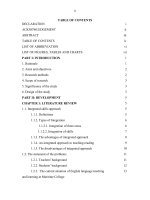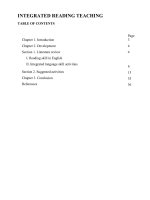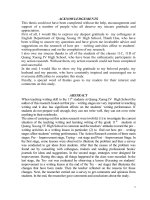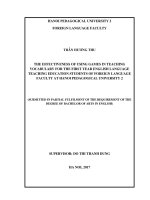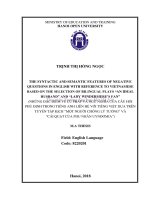The Canons of Nepali writing in English
Bạn đang xem bản rút gọn của tài liệu. Xem và tải ngay bản đầy đủ của tài liệu tại đây (347.77 KB, 12 trang )
TRIBHUVAN UNIVERSITY JOURNAL, VOL.: 31, NO.: 1 & 2, JUNE/DEC. 2017
63
THE CANONS OF NEPALI WRITING IN ENGLISH
Min Pun *
ABSTRACT
After Laxmi Prasad Devkota pioneered Nepali writing in English
in the 1950s, Mani Dixit, Tek Bahadur Karki, Abhi Subedi, Padma Prasad
Devkota, D.B. Gurung, Laxmi Devi Rajbhandari and a few others continued
to write in English during the 1960s, 70s and 80s. But Nepali writing in
English gained its momentum with the publication of Samrat Upadhyay's
Arresting God in Kathmandu in 2000 and Manjushree Thapa's The Tutor
of History in 2001. They were followed by a group of other aspiring Nepali
writers who emerged with their works in English that took over the global
readership. Therefore, this paper argues that Nepali writing in English has
achieved its canonical status with Laxmi Prasad Devkota, Samrat Upadhyay
and Manjushree Thapa as canons of Nepali writing in English.
Key words: Nepali writing in English; the 1990 political change; the first
generation, the second generation Nepali writers; literary canon
INTRODUCTION
With the 1990 political change in Nepal, a group of enthusiastic
Nepali writers emerged with significant English writings, taking over
the wider readership. They appeared with new themes and techniques
of writing as Manjushree Thapa (2009) claims, "In them we glimpse the
immense volatility – and the many struggles and gains – of Nepal's past
fifteen years" (p. vii). Some examples include Sushma Joshi, Rabi Thapa,
Sheeba Shivanagini Shah, Ajit Baral, Richa Bhattarai, M.K. Limbu, and
Aditya Man Shrestha. This trend indicates that the corpus of Nepali writing
in English, which is "a much newer phenomenon" (Hutt, 1993, p. 5), has
been rapidly expanding since the restoration of democracy in Nepal. In this
way, they paved a way for Nepali writing in English and inspired a group of
aspiring Nepali writers to follow their footsteps.
Nepali English writing now stands by itself as a body of literature
and has expanded its horizons to the global arena. In particular, Samrat
Upadhyay and Manjushree Thapa have made "important contributions to
*
Dr. Pun is Associate Professor in English, Prithivi Narayan Campus, Pokhara,
TU.
64
THE CANONS OF NEPALI WRITING IN ENGLISH
the field of Nepali English writing" (Uprety, 2011, p. 222) by publishing
internationally acclaimed works in literature. Now, it has reached new heights
after their publication. Should we now start debating the canon of Nepali
writing in English? Such question leads to other questions: Which Nepali
writers and works in English should be included in the canon? For instance,
Mani Dixit, Tek Bahadur Karki, Abhi Subedi, Peter J. Karthak, Ramesh
Shrestha, Padma Prasad Devkota, D.B. Gurung, Laxmi Devi Rajbhandari,
Deepak S. Rana, Kesar Lall, Dhruba K. Deep and M. L. Karmacharya have
come a long way from 1960s, 70s and 80s, and have continued to write
even today. If there is a canon in Nepali writing in English as such, should
they be included in it?
Since Nepali writing in English has begun to function like the
western canon, the works of English by Nepali writers have attracted a wider
readership (Pun, 2013b, p. 117). For instance, Upadhyay and Thapa are
familiar with academic circles of the west. This is because of their regular
presence there. They have also contextualized the question of literary canon
in Nepali writing in English.
THE QUESTION OF CANON
There is a question of canon What canon is! The simple answer
is that ‘canon’ is a list of major authors or works of literature; in the past,
it referred to philosophical, political, and religious texts considered as
fundamental by a particular group or society. More specifically, the term
'canon' refers to writers or works that either included in literature syllabi or
textbooks, or often appear in the compilations of “the history of literature,
bibliographies, and literary criticism" (Wilczek, 2012, p. 1687). It means
that the canon can be defined as organized set of characteristics possessed by
a writer, or his or her work that determine the status of canonicity. However,
the canon has come to be viewed by many as "the expression of cultural
authority created by other people influential in the past"; it has been defined
as "the space of cultural conflict" and as "debatable ground, the ground of
the battle between various groups, practices and institutions" (as cited in
Wilczek, 2012, p. 1687). Such definitions of the term can have one of two
outcomes: one, a new canon is established and two, the concept of a canon
is put into question. When a work of literature is categorized as canonical,
it needs to be assessed by specific validity. Such a work gains status as an
official inclusion into a group of writers, or works that are widely studied
TRIBHUVAN UNIVERSITY JOURNAL, VOL.: 31, NO.: 1 & 2, JUNE/DEC. 2017
65
and respected. But the issue of whether a writer or a work is canonized
remains a personal opinion.
After 1990, Nepali fiction writers Samrat Upadhyay, Manjushree
Thapa, Sheeba Shah and Sushma Joshi are some of the writers in English
who are part of the new generation of writers. Their works have taken
over in the wider world and have carried "a lot of implications in Nepalese
linguistic and ELT landscapes" (Karn, 2012, p. 37). In this way, with many
writers bringing out new books, the corpus of Nepali English literature is
rapidly expanding its horizons to the global arena. There still arises another
question: Do they have also provided a serious matter for the discussion of
whether Nepali writing in English has attained the canonical position?
HISTORY IN THE MAKING
English writing in Nepal dates back some six or seven decades. It
was in the 1950s that Laxmi Prasad Devkota started writing in English. It
was the time when Nepal had just emerged out from a century of isolation
from the outside world. In addition, the teaching and learning of English
was confined to a certain group of elites who were not interested in English
writing. It was only in 1959 that English was added to the higher education
curriculum. Most of the works in English in Nepal were the translated texts
until the end of 1980s; very few tried their hands in creative writing in
English.
Laxmi Prasad Devkota published three works of English: Bapu and
Other Sonnets, Shakuntala and The Lunatic and Other Poems, which were
originally written in English during the 1950s. His Bapu and Other Sonnets
contains fifty-nine sonnets, which were written when he was in exile in
India in 1949. Out of them, thirty eight were written in the memory of
Mahatma Gandhi (popularly known as Bapu) who led the Indian Movement
for Independence. His epic Shakuntala, a story from the Hindu mythology
Mahabharata, represents the eastern culture, values and heritage. His poetry
book The Lunatic and Other Poems includes thirty poems translated by
the poet himself, dealing with the "variety of themes, however, to be more
specific, the concept of 'Nature', sharp satire on socio-political situation and
caste based discrimination, love and memory, desire for change/revolution,
pride of nationality and importance of food formulate the major themes of
these poems" (Sharma, 2011, p. 47).
66
THE CANONS OF NEPALI WRITING IN ENGLISH
Devkota has also written criticism, stories and essays in English.
In fact, he has laid the foundation of writing literary works in English.
Some of his English translations were also published in Indreni, the poetry
magazine of Kavya Pratisthan (the predecessor of Nepal Academy). The
main purpose of his writing in English, as he argued, is "because of its
extensive use in India, especially in the Deccan and the different parts of
Asia and world" (as cited in Subedi, 1999, p. iii). Thus, his writing in English
was the need of the hour as Nepal opened its doors to the world after 1950;
it became free from the autocratic Rana rule and democracy was the system
of the nation. According to Krishna Chandra Sharma (2011), Devkota was
"true to express his individual self as a poet as well as committed to the
national spirit as a conscious citizen and performed a commendable role in
the establishment of democracy in Nepal" (p. 42). Apart from this, he also
helped establish Tribhuvan University and contributed to the promotion of
Nepali language and literature.
During the 1950s, Devkota was the sole writer to start creative
writing in English, which was a movement in English writing. His works
in English were "directly linked to Nepali modernity" and were "closely
related to English education and English as a medium of literary production
in Nepal" (Sharma, 2011, p. 42). The context for creative writing in English
was quite favourable at that time because Rabindra Nath Tagore, Mulkraj
Anand and Nirad C. Chaudahri were his contemporaries in India. However,
the context for creative writing in English was different in India and in
Nepal. In India, English became its official and second language and it had
the legacy of British Raj in India. English was introduced in India by the
colonial rule with a number of educational institutions that were established
throughout the country. Even when the British rule ended, it left behind the
language. But in Nepal, English was the second or even the third language
and it had no direct contact with the native speakers of English. Devkota,
in spite of this lacking in the linguistic context, saw great potentiality in
this language through which he and his native writers could enter into the
readership in the wider world.
It is important to ask a question here: Is Devkota the canon or just
the pioneer of Nepali writing in English? Devkota definitely pioneered the
first generation of Nepali writers in English. He should also be considered
the sole canon of the first generation Nepali writing in English. Followed
TRIBHUVAN UNIVERSITY JOURNAL, VOL.: 31, NO.: 1 & 2, JUNE/DEC. 2017
67
by him were other Nepali writers in English. They include Mani Dixit,
Tek Bahadur Karki, Ramesh Shrestha, Abhi Subedi and Peter J. Karthak
during the 1960s and 70s. Only three thin pioneering collections of poems
originally written in English published. The first was Sweet Steeple by Tek
Bahadur Karki and was published in 1966. It was in the single volume.
The second was Manas: A Collection of Poems, an anthology of poems
published in 1974, by the Nepali poets Ramesh Shrestha, Abhi Subedi,
and Peter J. Karthak. The book consisted of twenty one poems. Mani Dixit
published his non-fiction work Come Tomorrow: Gurkhas & Their Land in
1980. The book is about Gurkha soldiers who served for Indian and British
Army.
During the 1970s and 80s, a group of writers joined them. They
were Padma Prasad Devkota, Greta Rana, Kesar Lall, Prakash A. Raj,
Kesang Tseten, Manju Kachuli, Shailendra K. Singh, Yuyutsu R.D. Sharma,
Pallav Ranjan, Para Limbu, Laxmi Devi Rajbhandari and D.B. Gurung
who also belonged to the first generation Nepali writers in English. Their
works still appear in English though the tradition of writing in English after
Laxmi Prasad Devkota suffered much until the late 1980s. The lovers of
English works had to wait for two decades or so. A few works in English
appeared, however; mostly they appeared in English translations. Some
of the creative works of the time include H.M. Ansari' The Embrace of
Twilight (1986), Bandana Shrestha's Groping in the Dark Dawn (1988),
Greta Rana's Distant Hills and Right As It Is (1977), and Mani Dixit's Two
Towards Kantipur (1977). This list is not exhaustive.
In 1990, there was a mass protest against the Panchayat government
in Nepal. The movement aimed at restoring democracy. Opposition parties
joined the movement. Coincidentally, the government had a dispute with
India over the trade and transit agreements that created a highly favourable
situation for the uprising movement. Thousands of demonstrators and
activists were arrested and many newspapers were censored and even
banned. On April 6 the same year, many protesters were killed in a police
action when thousands of them were heading towards the royal palace in
Kathmandu. In retaliation for their demonstration, the Panchayat rulers
declared a curfew but it was futile. Panchayat rulers were forced years to lift
ban on political parties. Multiparty parliamentary democracy was restored
in Nepal after many years of party-less autocratic rule in the country. King
68
THE CANONS OF NEPALI WRITING IN ENGLISH
Birendra accepted his constitutional role, and an interim government that
included the agitating political parties was set up to redraft the country's
democratic constitution. The interim government was also responsible for
holding an election in 1991. With the advent of multiparty parliamentary
democracy in Nepal, the Nepali society opened up to the outside world.
Nepal was then an active member of the international community and a
popular tourist destination, and a major recipient of foreign aid. It progressed
in all sectors of development including road, health care, education,
communication, banking, and many others. Despite its opening up to the
outside world, it also went through the ten-year-long Maoist insurgency
that began in 1996 and that lasted with the end of the absolute monarchy
in 2006; King Gyanendra was forced to abdicate the crown absolute rule
following widespread protests. On May 28, 2008, Nepal was officially
declared a federal democratic republic by the newly elected Constituent
Assembly, ending the two and half century long monarchy.
Thus, the 1990 political change in Nepal is the starting point for
the second generation of Nepali writers in English that especially came up
with the emergence of two great writers: Samrat Upadhyay and Manjushree
Thapa. This begs a question: Are they the canons of Nepali writing in
English after Laxmi Prasad Devkota? The question is somehow tricky one
and its relevance needs to be addressed by the academic circle again. These
two are, however, followed by Sushma Joshi, Rabi Thapa, Sheeba Shah,
Ammaraj Joshi and a few others who are still struggling to be included in
the canon.
CANON IN THE MAKING
Samrat Upadhyay’s Arresting God in Kathmandu and Manjushree
Thapa’ The Tutor of History were gained popularity and were widely read
at home and abroad. They became a source of inspiration for many aspiring
Nepali writers to write in English (Pun, 2013a, p. 21). Followed by them
were Sushma Joshi, Sheeba Shivangini Shah and a few others. To give a
few examples amongst plethora of them: Joshi published The End of the
World in 2008 and Shah published Loyals of the Crown in 2005, Beyond the
Illusions in 2008 and Facing My Phantoms in 2010.
In 1999, a group of Nepali poets published Voices from Nepal, the
first major anthology of poems originally written in English. The poems
were written by Laxmi Prasad Devkota, Abhi Subedi, Padma Prasad
TRIBHUVAN UNIVERSITY JOURNAL, VOL.: 31, NO.: 1 & 2, JUNE/DEC. 2017
69
Devkota, D.B. Gurung, Tek Bahadur Karki, Laxmi Devi Rajbhandari
and Arati Dahal. In 2002, edited by Deepak Thapa and Kesang Tseten
and published by Martin Chautari, An Other Voice: English Literature
from Nepal includes poems by Padma Prasad Devkota, Tsering Wangmo
Dhompa, Wayne Amtzis, Manjul Kanchuli, E. Anne Hunkins, Kesar Lall,
Abhi Subedi, Greta Rana, Tek Bahadur Karki, D.B. Gurung, Hannah Chi,
and Yuyutsu R.D. Sharma. The book also consists of stories written by
Samrat Upadhyay, Manjushree Thapa, Kesang Tseten, Joel Issacson, Mani
Dixit, Sushma Joshi and Sunil Nepali.
New Nepal, New Voices: An Anthology of Short Stories edited by
Sushma Joshi and Ajit Baral is a notable work on English literature from
Nepal. This is a compilation of fifteen stories written by Nepali authors at
home and abroad. The stories are by Prawin Adhikari, Wayne Amtzis, Ajit
Baral, Sohan Dhakal, Smriti Ravindra, Sushma Joshi, Manju Kanchuli, Peter
J. Karthak, Sunil Nepali, Greta Rana, Madan K. Limbu, Tara, Manjushree
Thapa and Sanjeev Uprety. There is a list of novels, short story collections,
plays, poetry collections, and non-fiction works in English published by
Nepali writers in and outside Nepal. Some examples include Khem Aryal's
Kathmandu Saga and Other Poems, Padma Prasad Devkota's Dawn Cycle
and Other Poems, Sachendra Manandhar's It's All Written in the Stars, Abhi
Subedi's Chasing Dreams, Sangita Rayamajhi's All Mothers Are Working
Mothers, Mani Dixit's Over the Mountains, Rajan Prasad Pokharel's Rebels
of the Mountains, Sheeba Shivangini Shah's Facing My Phantoms, Samrat
Upadhyay's Buddha's Orphans, Manjushree Thapa's Seasons of Flight,
Kesar Lall's Folk Tales from Nepal: Myths & Legends, Archana Thapa's
Telling a Tale, and Sanjeev Uprety and Robin Piya's IMAP Reader: A
Collection of Essays on Art and Theatre in Kathmandu.
There is also a list of poems, stories, novels, plays, or travelogues
from the Nepali languages translated into English, which must be considered
to form part of Nepali writing in English. Himalayan Voices: An Introduction
to Modern Nepali Literature is the first attempt of English translation from
Nepali literature in the post-1990 era. The book is edited and translated by
Michael Hutt and was published in 1991. The book is an anthology of Nepali
poetry and short stories in English translation. It contains eighty poems
by twenty-one poets and twenty short stories by sixteen different authors,
providing "succinct and pertinent sketches of the historical, political, and
70
THE CANONS OF NEPALI WRITING IN ENGLISH
literary contexts in which the scholars worked" (Smith, 1993, p. 164). Hutt
illustrates new trends with a selection of contemporary poets and short story
writers. His translated book is followed by other Nepali translators who
translated Nepali literature into English, presenting before the world readers
"a glimpse of the Nepalese world reflected through the creative writings"
(Bhattarai, 2002, p. 68). Some of the examples of translated works include
Stories of Conflict and War, Muna Madan, Contemporary Nepali Poems,
The Voice of Mountains: A Collection of Modern Short Stories, Dancing
Sound of Mount Everest: An Anthology of Selected Modern Nepali Poems,
Women and Other Stories, The Wake of the White Tiger, Two Sisters: The
Poetry of Benju Sharma and Manju Kanchuli, Poems of Nepali Women, The
Country Is Yours: Contemporary Nepali Literature, and Palpasa Café.
The legacy of both writing originally in English and English
translation left behind by Laxmi Prasad Devkota was and is well developed
and practised by M.L. Karmacharya, Tirtha Raj Tuladhar, Daniel Khaling,
Tanka Vilas Varya, Taranath Sharma, Dhruba K. Deep, Kesar Lall, Chaitanya
Krishna Upadhyay, Madhusudhan Devkota and Abhi Subedi (Pun, 2013a,
p. 24). This was the beginning of English translation from Nepali literature
that is also as old as the tradition of writing in English in Nepal. It was
"evidently guided and motivated by translational situation" (Karki, 2002, p.
54). This practice was continuously followed by Tek Bahadur Karki, Padma
Prasad Devkota, Peter J. Karthak, Shanti Mishra, Shailendra Kumar Singh,
Nagendra Shrama, Govinda Raj Bhattarai, H.M. Ansari, Pallav Ranjan,
and Manjushree Thapa. There were also others whose English translations
appeared in the form of anthologies of translated works. Though some
translators such as Sondra Zeidenstein, Greta Rana, Michael Hutt, Larry
Hartsell, Maya Watson, Wayne Amtzis, Yuyutsu R.D. Sharma, and Philip
Pierce have helped promote the field of English translation in Nepal. But
Interestingly their mother tongue is not Nepali.Nepali writing in English
is not only the original works in English and English translation, it also
comprises of the works in English produced in diaspora. The history of
Nepali writing in diaspora is brief, but it has contributed to the enhancement
of Nepali writing in English.
The above discussion indicates that creative writing activities have
thrived in Nepal and therefore it is important to study them and initiate
academic discourses on how and at what point English literature produced
TRIBHUVAN UNIVERSITY JOURNAL, VOL.: 31, NO.: 1 & 2, JUNE/DEC. 2017
71
in Nepal diverges from other English writing in the world. Is there such
a thing as Nepali writing in English? If there is, it should be discussed
with Nepali English writers who have struggled hard for achieving literary
height in Nepal and abroad. It is necessary to mention a name here. He
should be Laxmi Prasad Devkota whose name can be considered the first
canon of Nepali writing in English. There are reasons and parameters for
being as such: One of them is his inclusion in the university syllabi. His
English works have been included in the courses of Tribhuvan University
and Pokhara University. Other two Nepali writers to be included in the
Nepali English canon should be Samrat Upadhyay and Manjushree Thapa
(Pun, 2013b, p. 126). They should also be considered the canons of Nepali
writing in English. There are many reasons: one of them is that they are
internationally acclaimed writers whose works have taken over the wider
readership globally. In addition, they should be considered great writers
in terms of their writing quality and thematic presentation. However, the
debate over the canonization of a threesome will continue to take place in
academic discourses. Of course, we can recite the names of all of them on
the list even if the literary canon does not exist. It means that the works
in the canon get read; they should be read by students, teachers, scholars,
critics and many more readers, and so do our threesome.
WHO DETERMINES THE CANON?
The western tenets suggested that when the best ideas and thoughts
can be presented in any writing, it can be said to have achieved its canonicity.
In this sense, we can use these tenets to legitimize the canonicity of Nepali
writing in English. But because of the emergence of a rich body of writing
under postcolonial literature, the western tenets also have acquired startlingly
transformed status. It is quite relevant to observe the claim made by John
Marx (2004) who said: "The fact that a writer's capacity to represent a place
and its people is widely considered relevant to determining canonicity
suggests how dramatically postcolonial literature has changed what we
mean when we say 'the canon'" (p. 85). It suggests that the canonical status
of Nepali writing in English has neither questioned the western canon nor
functioned as a counter-canon. But Nepali writing in English has earned
critical acclaim, some Nepali writers have already attained canonical status
and some others still struggling for the canon. However, there are many
72
THE CANONS OF NEPALI WRITING IN ENGLISH
who oppose this argument primarily out of political interests, arguing that
the very idea of canon does not exist in Nepali writing in English.
The ongoing debate, motivated by politics and social agenda over
the nature and status of the canon has been there since the 1990s, much of
which is rooted in the question of whether it is time to debate on the issue.
In particular, as Abhi Subedi (1999) claims, "In Nepal, the canonicity of the
postcolonial legacy continued to dominate the literary culture even without
the use of English" (p. iv). He means to say that one of the main objections to
a canon of Nepali writing in English is the question of authority: Who should
have the power to determine what works are worth reading and teaching? In
principle, the literary canon of a certain group or community is consisted of
a body of works that are highly valued by literary critics, scholars, teachers,
and readers. It happens because their works contain certain aesthetic
value, and represent certain cultural and political values of that group
or community. When they are canonized, they become institutionalized,
constantly including in the syllabi and taught in the educational institutions
(Pun, 2013b, p. 129). Seen in this way, the question of the status of Nepali
writing in English as canonical works is yet to be determined: should they
be an important part of the educational curriculum, informed by the literary
canon? Such a question is debated constantly both by academics and nonacademics after the 1990 political change in Nepal.
CONCLUSION
In conclusion, the recent development indicates that Nepali writing
in English is entangled in the process of canon formation. It is now high
time to debate the canon in question since a discourse of canon formation in
Nepali writing in English harks back as far as the early twenty-first century.
As far as the inclusion of Nepali English literary texts in the educational
syllabi is concerned, the growth of English writing in Nepal is significant
after the 1990 political change in Nepal, especially in terms of number
and quality it represents. In spite of the debate and controversy over the
canonization of Nepali writers and their works in English, there will be
three Nepali writers in English who will be considered the canons of Nepali
writing in English. There will also be lists of other Nepali bestsellers, mustread books, and books that changed the world. But most Nepali readers
would react to this list with astonishment. I would rather ask a question
– why not include all Nepal writers in the canon who write in English?
TRIBHUVAN UNIVERSITY JOURNAL, VOL.: 31, NO.: 1 & 2, JUNE/DEC. 2017
73
In fact, they can be considered good poets, novelists, dramatists, essayists
and so on. But the question again is: do they really deserve to be one of
three canons of Nepali writing in English: Laxmi Prasad Devkota, Samrat
Upadhyay and Manjushree Thapa?
ACKNOWLEDGEMENTS
This paper is based on my research project on Nepali writing in
English which was completed in September 2013, in financial collaboration
with the Research Division of University Grants Commission (UGC),
Kathmandu. I would like to thank the Research Division for its invaluable
research grant.
WORKS CITED
Bhattarai, G.R. (2002). Bridging gaps in translation: An experience of
rendering Nepali short fiction into English. Journal of Nepalese
Literature, Art and Culture, 4(2), pp. 68-70.
Hutt, M., (Ed.) (1993). Introduction. Himalayan Voices: An Introduction
to Modern Nepali Literature (pp. 1-9). Delhi: Motilal Banarsidass
Publishers.
Karki, T. B. (2002). The tongues of translation. Journal of Nepalese
Literature, Art and Culture, 4 (2), pp. 51-57.
Karn, S.K. (2012). This is how I can write: Towards Nepalese English
literature. Journal of NELTA, 17(1-2), pp. 26-39.
Marx, J. (2004). Postcolonial literature and the western literary canon.
Cambridge Companion to Postcolonial Literature (83-96). In John
Marx (Ed.). Cambridge: Cambridge University Press.
Pun, M. B. (2013a). The emergence of Nepali writers in English after the
1990 restoration of democracy in Nepal. Sanothimi, Bhaktapur:
University Grants Commission.
Pun, M. B. (2013b). Nepali writing in English and the 1990 people’s
movement in Nepal: Exploring the literary canon. Crosscurrents:
A Journal of Language, Literature and Literary Theory, 2(1), pp.
114-131.
Sharma, K.C. (2011). A critical recount of English-Nepali poetic translation.
Journal of Nepalese Literature, Art and Culture, 6(2), pp. 42-52.
74
THE CANONS OF NEPALI WRITING IN ENGLISH
Smith, W. L. (1993, Jan.-Mar.). Review of Himalayan voices: An introduction
to modern Nepali literature by Michael James Hutt. Journal of the
American Oriental Society, 113(1), pp. 164-65.
Subedi, A. (1999). Nepali poetry in English: An insider's view. Voices from
Nepal: The First Major Anthology of Poems Originally Written in
English by Nepalese Poets (iii-v). Kathmandu: Shanta Malla.
Thapa, M., (Ed.), (2009). Introduction and acknowledgements. The Country
Is Yours: Contemporary Nepali Literature (v-viii). Kathmandu:
The Printhouse.
Uprety, S. (2011). Nepali English writing: Problems and possibilities.
Crosscurrents: A Journal of Language, Literature and Literary
Theory, 1(1), pp. 221- 32.
Wilczek, P. (2012, September). The literary canon and translation: Polish
culture as a case study. Sarmatian Review, pp. 1687-92.




